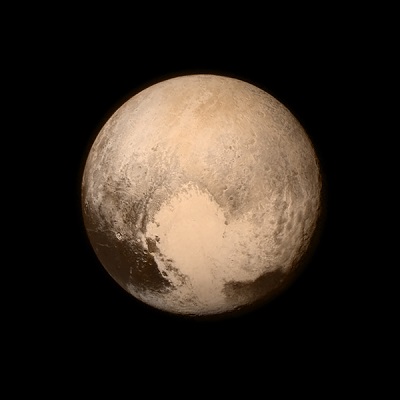Pluto Facts: Tiny, icy world gets major attention

This July 13, 2015 image provided by NASA shows Pluto, seen from the New Horizons spacecraft. The United States is now the only nation to visit every single planet in the solar system. Pluto was No. 9 in the lineup when New Horizons departed Cape Canaveral, Florida, on January 19, 2006. AP
CAPE CANAVERAL, Florida, United States — Pluto’s tiny, icy world is getting major attention for its first visit by a spacecraft, NASA’s New Horizons.
Tuesday’s flyby — with the closest approach being the approximate distance between Seattle and Sydney, or New York and Mumbai — is expected to open up new ground on the last unexplored planetary territory of our solar system.
Here’s a rundown on Pluto, a 20th-century discovery about to become the 21st-century darling of astronomers:
DISCOVERY
Pluto is the only planet (OK, now former planet) in our solar system discovered by an American. Astronomer Clyde Tombaugh spotted the dot in 1930. The name Pluto came from a British schoolgirl, Venetia Burney, then 11, based on the mythological god of the underworld.
Tombaugh died at age 90 in 1997, nine years before New Horizons took flight. A bit of his ashes is on board.
Both of Tombaugh’s two children, now in their 70s, were at the New Horizons mission operations center for Tuesday’s celebration.
FIVE MOONS
Big moon Charon was discovered in 1978, followed by little moons Nix and Hydra in 2005, Kerberos in 2011 and Styx in 2012. The Hubble Space Telescope revealed all four baby moons. Astronomers stuck to underworld undertones when it came to the names.
New Horizons will hunt for more moons, but at this point, they would have to be pretty elusive. The Pluto empire, complete with six bodies, at least for now, is like its own mini solar system.
FORGET THE SUNGLASSES
Pluto is so far from the sun — between 2.8 billion and 4.6 billion miles — that twilight reigns. At high noon on Pluto, it looks as though it would be dawn or dusk on Earth.
It takes 248 years for Pluto to orbit the sun. Thus, it’s only made it about one-third of the way around the sun since its discovery in 1930. Every so often, Neptune’s orbit exceeds Pluto’s, putting Neptune slightly farther out.
FIRST A PLANET, THEN IT’S NOT
Pluto is the only planet to get kicked out of the solar system club.
Just seven months after New Horizons rocketed away from Cape Canaveral, Florida, in 2006, the International Astronomical Union declassified Pluto as the ninth planet for technical reasons. Instead, it became a dwarf planet.
The decision left the solar system with eight full-fledged planets, with Mercury replacing Pluto as the smallest.
New Horizons scientists, as well as NASA’s leaders, are hoping the new pictures will restore Pluto’s planet status.
THE TWILIGHT ZONE
Pluto is the biggest object in the icy Kuiper Belt, also known as the third zone after the inner rocky planets and outer gaseous giants.
The Kuiper Belt is full of comets and other small frosty objects. It’s named after the late Dutch-American astronomer Gerard Kuiper, who proposed a bevy of small bodies beyond Neptune back in the 1950s. The New Horizons team hopes to go after a smaller Kuiper Belt object following the Pluto flyby, provided a mission extension is approved.
___
Online:
Johns Hopkins University: https://pluto.jhuapl.edu/